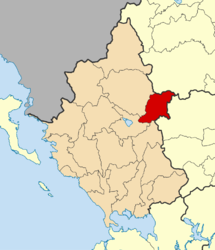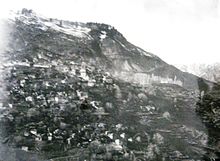Metsovo
Metsovo (Greek: Μέτσοβο; Aromanian: Aminciu) is a town in Epirus, in the mountains of Pindus in northern Greece, between Ioannina to the west and Meteora to the east.
Alternatively, there appears to be an etymological relation between the Aromanian Minʤu and the Greek Metsovo, the latter being a combination of the stem Mets and the Slavic-ending ovo.
[4][5] Throughout the late period of Ottoman rule (18th century-1913) the Greek and Aromanian population of the region (Northern Pindus) suffered from Albanian raiders.
[8] In the last 10 days of October 1912, military volunteers from Crete, together with about 340 soldiers of the tactical Greek army under the command of Lieutenant Colonel Mitsas, advanced through Thessaly to the then Greek-Turkish border along the mountains east of Metsovo.
The battle lasted until 4 p.m. when the Ottoman soldiers inside the besieged Turkish garrison raised a white flag and surrendered.
Socially, the residents of Metsovo, up until the beginning of the 20th century, were divided into three classes: the "arhontzi" (arxondzɨ),[3] the "vinitsi" (vinitsɨ) and the "algi" (alɟi) or, mockingly, "gizari" (ɟizari).
The love for their birthplace and the social altruism of the Metsovites living abroad resulted in the amassing of significant benefactor funds in Metsovo.
Beneficence by Metsovites is a powerful phenomenon, the dimensions of which were formed through the processes relating to the socioeconomic growth of Metsovo during the Ottoman period.
Despite the long absence of the men of the community from Metsovo, due to their business and commercial activities, their hometown remains in their hearts as their financial and family seat.
Consequently, a large part of their revenue is channeled into the local economy by themselves or their families, as charity or investment capital to be used for the conservation of the social and political superiority of their class.
At first, their social solidarity is expressed as a church-sponsoring funding activity according to the standards of a cultural notion that derives from the medieval past of the Orthodox church.
The "Catholic Exarch of Metsovo"—a person appointed by the Patriarch of Constantinople—resided in Constantinople and was paid 15 kuruşlar annually for his role as supervisor of the region.
In actuality, his duties were performed by a local clergyman, who was elected by the people of Metsovo, approved by the patriarchate, and was obliged to act in the name of the catholic exarch.
The spiritual jurisdiction of the exarch comprised the settlements of Metsovo, Anilio, Derventista (now Anthohori), Votonosi, Milia, Koutsioufleani (now Platanistos), and Malakasi.
In 1924, the Exarchate of Metsovo was temporarily upgraded to a metropolis, in order to accommodate the placement of clergy from Asia Minor who had lost their seats.
Indicative of these efforts is the establishment of a school as early as the beginning of the 18th century, the continuous care to maintain its operation, and studying abroad in European universities to receive higher education.
The result of this process is the appearance of a class of scholars, teachers, and clergymen who participate actively in the intellectual life in the territories of modern Greece.
Taking into account the fact that the residents of Metsovo had been migrating for a long time, it is difficult to determine the beginning of its commercial growth.
By the end of the 18th century there is an established community of merchants in Metsovo, which, through a collaborative or overlapping trade network, spread its operations over a rather extensive geographic area.
Records show that Metsovite merchants had a permanent presence in the following cities and towns: Corfu, Serres, Filippoupoli, Odessa, Brody, Moscow, Petersburg, Sevastopol, Nizna, Thessaloniki, in the Romanian cities of Orsova, Chisinau, Iasi, Ismail (Bessarabia), Craiova, Focsani, Galatsi, and Odessa, and a presence in the trade fairs and open-air markets of Perlepe, Sistov, Uzungiova, Rostov, Smyrna, Cyprus, and Damascus.
In 2006, the junction between the A2 motorway and a section of Greek National Road (Ioannina – Trikala) made for a superhighway with two exits at Metsovo.
The town is famous for its local cheeses (Metsovone and Metsovela, among others)[15] and for its winemaking industries, including the Katógi vineyard of the Averoff family.












